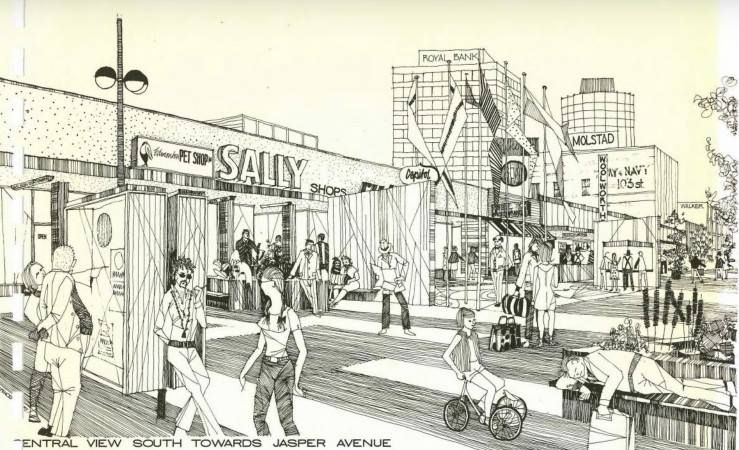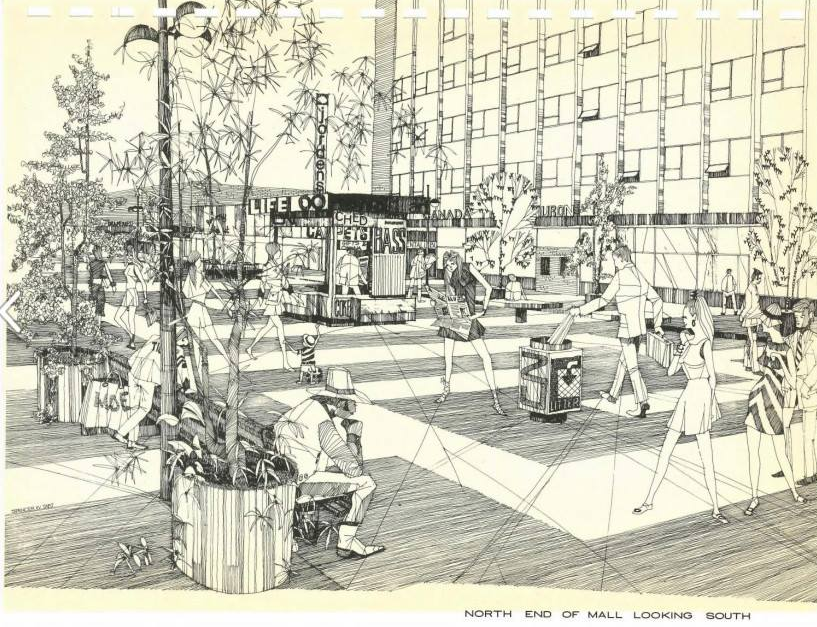Pedestrians walk on Stephen Avenue on Wednesday, August 7, 2019. PHOTO BY AZIN GHAFFARI /Postmedia Calgary
At City Council on December 6, 2021, Councillor Anne Stevenson put forward the following motion (video starts at 9:24:10):
That Administration explore the opportunity to pedestrianize 102 Avenue adjacent to Valley Line LRT and return to Urban Planning Committee with options for consideration.
The motion passed unanimously, and is due to come to Urban Planning Committee on March 8, 2022, at which time the public will be able to speak to the committee (and we encourage you to do so in support of 102 Ave!).
The report will look at a high level at the technical feasibility and costs of potential options. You can read more about the proposal from Paths for People, who spearheaded this idea.
Calgary already has Stephen Avenue, but Edmonton doesn’t currently have any pedestrian streets. But this is not the first time that a pedestrianized street has been proposed for Edmonton.
In 1968, Edmonton proposed an open air pedestrian mall on 102 St, north of Jasper Ave. The report opens with a focus on how the core lives or dies not by ease of driving, but rather by what happens once people exit their vehicles:
Direct accessibility was, at one time, the principle requirement for a thriving City Centre. In the Edmonton of today however, this is no longer the case. While one may be able to reach the City Centre by car, bus, and in the near future rapid transit, nevertheless there can be very little exchange of goods and ideas (the principle "raison d'etre" of the City Centre) until one leaves his motor car, bus, or train. In the City Centre goods and ideas are exchanged by way of direct face to face contact: Downtown Edmonton can function in no other way. How satisfactorily the City Centre functions directly depends upon how safely, comfortably, and conveniently, goods and ideas can be exchanged.
The introduction continues with this suprisingly figurative section:
Downtown is the heart of Edmonton. As in the human body, a strong heart is an essential element to a healthy body. If the heart of Edmonton is to properly satisfy the needs of its citizens, improved provision must be made for pedestrian activity and movement.
No one denies that, in order to function, vehicles of all types must have access to the City Centre. But at the same time we must never forget that the success of the City Centre depends directly upon the ease with which goods and ideas can be exchanged through the medium of face to face contact. While traffic arteries are essential, the City Centre, as the principle activity core of Edmonton, will die if it is entirely converted to arteries, resulting in very little room remaining for "heart".
The report also mentions plans to turn 101 A Avenue (now Rice Howard Way) into “an urban park — an area considered essentially for passive relaxation”.
The appendix of the report includes a description of a public meeting where, while the reaction was on the whole favourable, “a small number of retailers voiced misgivings as to the effect ot he proposals on their businesses”. A “small but vocal group” of people claimed that, in the similar Sparks Street Mall in Ottawa, “adjacent shopping streets suffered a decline in trade and property values fell”.
“Whilst members of the Planning Department had previously conducted research and responded to the arguments at the meeting”, the group remained unconvinced.
The appendix includes statements from Ottawa officials confirming that property values had increased both on the Mall and in the surrounding area, and none had dropped. They also emphasized that:
its implementation had acted as a "blood transfusion" to the Downtown Area which had been decaying as a result of decentralization, competition from outlying shopping centres and the accessibility of Montreal by special "shopping" train services. The Mall had given confidence to developers interested in the Downtown Area, and had encouraged the development of a large hotel, office and commercial centre nearby.
View the original report here: The Mall: 102 St Pedestrian Mall Report (1968).
And check out the detailed proposal for 102 Ave from Paths for People:
Bonus update: In 1984, the Mayor's Task Force on the Heart of the City: A Blue Print for the 21st Century also recommended pedestrianizing 102 St, this time as a covered arcade!











